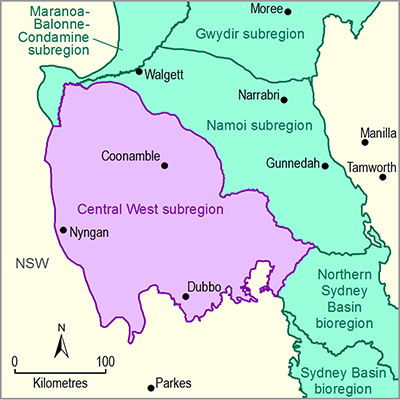1.1.3.3.1 Tectonic evolution
Rapid subsidence caused by mechanical extension during the Early Permian initiated development of the Gunnedah Basin. This resulted in the widespread deposition of a thick package of volcanic rocks (Werrie Basalt and Boggabri Volcanics) and inter-layered lacustrine sedimentary rocks (Totterdell et al., 2009). The next major phase of basin subsidence was caused by plate flexure due to foreland loading (Totterdell et al., 2009). This was the dominant process driving basin evolution from the latest part of the Early Permian until the Middle Triassic, and led to the deposition of all stratigraphic units in the basin that post-date the Maules Creek Formation (Totterdell et al., 2009). However, subsidence associated with foreland loading was interrupted by a Late Permian to Early Triassic deformational event that halted deposition and caused localised uplift and erosion (Korsch and Totterdell, 2009).
During the Middle to Late Triassic, the deposition of the sedimentary sequences in the Gunnedah Basin ceased (O’Neill and Danis, 2013). This was caused by a major contractional event that was widespread in the basin, and led to significant uplift and erosion (Tadros, 1993; Danis et al., 2010; O’Neill and Danis, 2013). Extensive mafic igneous activity occurred throughout the Gunnedah Basin (and nearby regions) in the Late Triassic and Early Jurassic, including volcanic eruptions (Garrawilla Volcanics) and emplacement of shallow crustal intrusive rocks (Danis et al., 2010; O’Neill and Danis, 2013). Following this magmatic activity renewed basin subsidence was driven by tilting of the eroded platform sequence associated with nearby plate subduction (Cadman et al., 1998). This led to the widespread deposition of the fluvial to marginal marine sedimentary sequences of the Surat Basin, with mostly continuous sedimentation from the Early Jurassic to the Early Cretaceous (Totterdell et al., 2009).
The Early Permian brought a rise to the formation of the basin during marine transgression, which was briefly interrupted by a progradation in the northern section of the basin, forming the Greta Coal Measures. Transgression then continued into the early Late Permian when the regressive or transgressive Muree and Nowra sandstones were deposited (Mayne et al., 1974; Harrington et al., 1989; Cadman et al., 1998). It was during the Middle Permian that the Hunter-Mooki Thrust activated and stayed active through to the Late Permian (Cadman et al., 1998). At this time the continued uplift of the adjacent New England Fold Belt resulted in regressive deposition interrupted by small marine insurgences (Mayne et al., 1974; Cadman et al., 1998). During the end of the Late Permian, continued Hunter-Mooki Thrust activity uplifted the New England region ceasing coal swamp environments (Cadman et al., 1998). Basin-wide subsidence then brought on a marine regression, followed by a transgression event (Mayne et al., 1974; Bradley et al., 1985; Cadman et al., 1998). A rift also formed in the Sydney region and propagated west through the basin, known as the Ayr Volcanic Rift (Harrington et al., 1989). Maturation data suggest the deposition and removal of sediments during the Jurassic and Cretaceous extensional tectonism. A compressive regime returned to the basin in the Tertiary (Cadman et al., 1998).
1.1.3.3.2 Paleozoic volcanism and intrusion
Extension during the Late Carboniferous and Early Permian brought on a volcanic phase that gave rise to the Boggabri Volcanics and Werrie Basalt (Danis et al., 2010; O’Neill and Danis, 2013). Thin layers of tuff also occur sporadically throughout some parts of the Gunnedah Basin sequence, for example in the Melville and Hoskissons coal seams (Hamilton, 1985). These provide evidence for minor pyroclastic volcanism in the Late Permian sequences of the Gunnedah Basin. Reactivation of volcanic activity in the Gunnedah Basin during the Jurassic, caused by the separation of Pangaea and eastern Gondwana, led to deposition of the Garrawilla Volcanics in the north and west of the Gunnedah Basin (Danis et al., 2010; O’Neill and Danis, 2013).
Igneous intrusions, such as the Black Jack Sill and Ivanhoe Sill, are common throughout the Gunnedah Basin sequence, and are thought to be mostly of Jurassic and Early Cretaceous age (Ward and Kelly, 2013; Pratt, 1998). The thickness of sills varies greatly, from a few centimetres to over 120 m thick (Ward and Kelly, 2013). In places where intrusions are adjacent to coals, coal seam gas contents are commonly elevated due to micro-fracturing of the seam (Ward and Kelly, 2013). Sills have also increased the thermal maturity of coals and led to enhanced hydrocarbon production (Ward and Kelly, 2013).
Three main phases of volcanic activity, the Permian to Carboniferous New England Fold Belt, the Mesozoic New Zealand Fold Belt and the Cretaceous to Tertiary Tasman Rift Valley and Tasman Sea (Mayne et al., 1974). The oldest sedimentary rocks within the Sydney Basin are composed, at least in part, of volcanic material similar to that of the New England Fold Belt (Mayne et al., 1974). The material recovered in several deep wells is thought to be a remnant of a diatreme from the Triassic period (Mayne et al., 1974). Various sills, plugs, flows and tuffs of Permian, Jurassic, Cretaceous and Triassic age are located within the Sydney Basin (Mayne et al., 1974).

